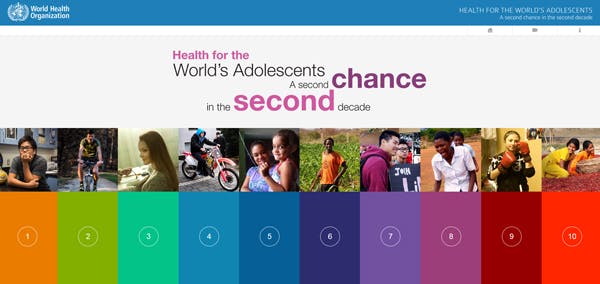By Jane Ferguson, Scientist at the World Health Organization’s Department of Maternal, Newborn, Child and Adolescent Health
There are more than 1 billion adolescents and most are healthy. But an estimated 1.3 million young people aged 10 to 19 died in 2012, mostly from preventable or treatable causes, and many more suffered needlessly from injuries and illnesses.
The World Health Organization’s new report, Health for the World’s Adolescents, analyses the current situation and makes a series of recommendations. Here are five of its main points:
1. Teenagers really are different: Adolescents undergo physical, mental, and emotional changes, often affecting the way they think and act and how society views them. Decisions and behaviour at this stage of life can affect future health. It is also a time when teens can catch up physically and mentally if their development was affected in childhood. Adolescents are not big children or small adults, but need explicit attention – attention that to date has largely been lacking.
2. Risky time, risky world: Road injuries are the biggest cause of death of teenagers – some 120,000, many of them pedestrians, were killed in 2012. Good transport planning can help reduce fatalities. Adolescence is also a time when risky behaviour can begin. Countries need to ensure teens can get information and services for safe sex. States also need to effectively limit adolescents’ access to alcohol and tobacco.
3. Not just moody: Depression is the top cause of illness and disability among adolescents, and suicide is the third cause of death. Half of all mental health disorders in adulthood appear to start by age 14, but most cases are undetected and untreated. The mental health of teenagers is a public health priority.
4. Healthy eating and exercise matter: Nutritious food and physical activity are the foundations of good health as an adult. Lack of iron and resulting anaemia can have a big effect on the health of girls and boys. Adolescent obesity is increasing in both low- and high-income countries. Reducing the marketing of foods and drinks high in saturated fats and sugars, for example, and increasing teenagers’ access to healthy foods and opportunities for exercise are key.
5. Setbacks and successes: HIV-related deaths among adolescents have increased between 2000 and 2012, with most of the cases in sub-Saharan Africa. Diarrhoea and lower respiratory tract infections are still among the main diseases affecting 10 to 14 year olds. But improved childhood vaccination led to a dramatic fall in teenage deaths and disability from measles. Teenage deaths due to complications during pregnancy and childbirth have declined a lot, but they are still the leading cause of death among 15 to 19 year old girls globally, exceeded only by suicide.
Health for the World’s Adolescents can help policymakers and the health sector to plan and provide care and services for adolescents and also in their work with other groups, including families, schools, and, of course, teenagers themselves.
Let’s use this second decade of the century to improve health in the second decade of life. It is in all our interests to do so.
Editor’s Note: To learn more about WHO’s work, follow @WHO on Twitter.



 View All Blog Posts
View All Blog Posts